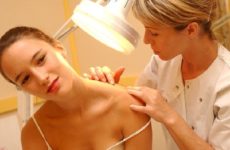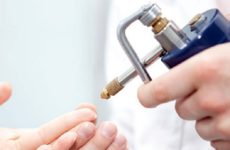Содержание:
- 1 Introduction
- 2 Varieties of formations on the legs
- 3 Causes of growths on the sole, foot in children
- 4 How can you get a viral wart?
- 5 What does education look like: signs and symptoms?
- 6 Is there a danger for children?
- 7 Methods for diagnosing growths in children
- 8 Treatment at home
- 9 Indications for the operation
- 10 Operative ways to remove growths
- 11 Prevention
- 12 Conclusion
Introduction
Often, parents of children of school and preschool, and sometimes even infancy, are faced with such a phenomenon as warts on the feet.
This viral disease is caused by the development of HPV ( human papillomavirus ) in the body and requires immediate treatment. Untimely assistance can lead to a fairly rapid spread of warts throughout the body.

The presence of such an ailment brings the child not only physical, but also psychological discomfort, since, unfortunately, this is an occasion for ridicule among peers and older children.
Varieties of formations on the legs
Experts call several types of warts on the heel , which may appear on the legs:
- Ordinary . This type is characterized by: a slight change in skin color, small size, spherical shape and slight peeling. Most often, warts of this type are formed on the knee joints.
- Flat . Smooth, in some cases slightly raised above the surface of the skin, formations of light brown color with a pinkish tint. In most cases, the knees, toes and top of the foot are affected.
- Plantar . Dense formations of a dirty yellow color with a gray tint. Affect the feet in the area of the fingers or closer to the heel. This type is characterized by painful sensations, as well as a keratinized structure and severe peeling.
Causes of growths on the sole, foot in children
The human papillomavirus in early childhood settles in 90% of people. But it doesn’t show up for everyone. To start the processes of cell mutation and the spread of the virus throughout the body, there must be contributing factors.
Doctors identified the main “helpers” of HPV, they became the main causes of warts:
- excessive sweating of the extremities;
- tight, calloused shoes;
- violations of the integrity of the skin cover associated with mechanical damage or dermatological diseases;
- decreased immunity after a long course of taking antibacterial drugs;
- neglect of the rules of personal hygiene, for example, the use of other people’s towels, washcloths, shoes, etc.;
- exacerbation of gastroenterological diseases;
- high emotional stress;
- severe diseases (such as diabetes, hepatitis, oncology).

The wart itself is a growth formed due to a mutation of skin cells. They mutate, having fallen under the influence of HPV, developed in the body of a child. The virus is contact and is transmitted through touch, objects, etc. Viruses are transmitted especially well if there are cracks, cuts, scratches, etc. on the skin surface.
It is children of school and preschool age who are susceptible to the disease, since HPV does not cause any changes in the body with strong immunity.
Infants are also less susceptible to this virus, due to the fact that they are protected by the mother’s immunity, transmitted through breast milk. In addition, babies have almost no contact with other people or household items, unlike older children.
By the age of 21-23, human immunity enters its most powerful phase, and the risk of infection is reduced to the very minimum. It is worth noting that the virus does not manifest itself immediately after entering the body.

What does education look like: signs and symptoms?
The human papillomavirus can manifest itself in two states: active and passive. In a passive state, it develops so slowly that it does not reach the upper layers of the epidermis.
Therefore, the passive residence of HPV in the body does not have any symptoms. But in the active state, it has many distinctive features in different parts of the body.
The following describes how to distinguish a wart on the foot from other types of formations:
- Round or oval formation with a diameter of up to 1 cm.
- May protrude 1–2 mm above the skin surface.
- Pale yellow color (possibly with a grayish tinge) does not really stand out against healthy skin.
- As it grows, it becomes thicker and more protruding.
- The keratinized layers of the epithelium begin to peel off.
- Often there is a pronounced point in the middle in the form of a bulge, or, conversely, a hole resembling a funnel.
- In the process of growth, signs of inflammation appear around.
- Accompanied by painful sensations that increase with exercise (walking, close contact with shoes, etc.).
- If the wart is damaged and bacteria enter, a purulent inflammatory process can begin. In this case, induration and redness intensify, and painful “pulsating” sensations appear even in a state of complete rest.

Is there a danger for children?
A plantar wart , better known as a ” thorn ” does not pose a danger in itself if hygiene control is increased. A big cause for concern is the cause of its appearance – HPV and a sharp decrease in immunity.
The body gives signals about violations of certain functions and, of course, requires a response. Noticing a spine in a child, it is best to contact a specialist.
Before determining the course of complex treatment, he will exclude the formation of melanoma (skin cancer), which has extremely high mortality rates. Timely access to a doctor will reduce the risk of unpleasant complications for the child and his parents.
Methods for diagnosing growths in children
In order to accurately diagnose the growth formed on the foot, it is enough to contact a specialist dermatologist. It is enough for him to interview the patient, visual examination and, in some cases, palpation, in order to determine whether it is a wart or not.
Further, general blood and urine tests are taken to determine the degree of inflammation in the body, and a biopsy is performed to determine the type of virus.
After that, the specialist will be able to prescribe a comprehensive treatment, which includes the fight against the virus from the inside and the elimination of external manifestations.

Treatment at home
If a spike is found, then you can try to deal with it yourself. This can be done both with the help of pharmaceutical preparations and folk remedies.
The use of pharmaceutical preparations for treatment
The choice of means of dealing with spines is great. For children, special ointments against warts are produced:
- Cream “Chaga” – applied before bedtime every evening for a month. The composition based on the fungus of the same name has long established itself as a remedy for plantar warts.
- Tebrofen ointment 5% – applied twice a day to the affected areas. Feet must be clean and dry. The course lasts 2 weeks.
- Cream “Supercleaner” – the name directly indicates the main component. The cream is applied under the patch. Due to the presence of alkali in the composition, the formation is burned out and disappears. The course of treatment lasts until complete recovery.
- Imiquimod ointment – the course lasts no more than 2 weeks. The drug affects not only the spine itself, but also has an antiviral effect by stimulating the production of protein structures aimed at strengthening and activating the immune system. Other ointments have the same properties, for example: viferon, oxolinic ointment, panovir. All of them are absolutely safe for healthy skin areas. It is better to consult a specialist about the duration of the course of treatment with a specific drug, and if you use it yourself, carefully study the instructions.
- Salicylic ointment or salicylic acid are drugs that must be used very carefully. When burning a wart with these remedies, healthy areas around the affected area may be damaged. Treatment is considered effective, but long. Other products that include salicylic acid are suitable as a replacement. It can be: collomak , salipod, duofilm.
- You can also use solutions with a cauterizing effect . The most popular of them are iodine and silver nitrate. Their use is recommended only in combination with antiviral drugs for internal use.

Remove the growth in folk ways
Not everyone is ready to turn to medicines. Our ancestors fought warts with folk remedies, some of the methods are still relevant today:
- Celandine . The one that is part of the drugs listed above. Celandine juice is squeezed out and applied to the affected area 3-4 times a day, gradually burning out mutating cells and keratinized layers. If the spike is deep, celandine juice can be mixed with baking soda. This will provide a deeper impact.
- Vinegar . Vinegar treatment is an effective method, but very dangerous. This method easily and freely burns out warts, but burns healthy areas of the skin around. Application must be extremely careful.
- Dandelion . The method is effective, but it is not available all year round. Dandelion juice “kills” the wart, it dries up and falls off. Processing is carried out 3-4 times a day.4. Aloe. The leaf of the plant is torn off and divided in half. The open side is applied to the wart and fixed with a plaster or bandage for the whole day. In the morning the dressing is changed. Treatment lasts for a month.
- Garlic . The clove is cleaned, cut and applied to the affected area. It is fixed with a bandage or plaster for the whole day.
- Potatoes . Use clean fresh grated potatoes in the form of compresses.
- Kalanchoe . The most popular way. Many opt for it, due to its effectiveness (the reduction of the wart is already visible on the 5th day), as well as safety. The recipe is simple: the leaves of the plant are thoroughly washed and applied to the affected area. The compress is fixed with a bandage.

Folk remedies can be effective, but you should not abuse them, especially if there is no result at all.
Indications for the operation
The main indications for surgical intervention and removal of the wart are symptoms of complications: increasing pain, bleeding, growth, change in color and shape, or extensive damage to the skin.
All this suggests that in no case should the patient use external agents (ointments, creams, etc.), but it is necessary to urgently contact a dermatologist, and he will already make a final decision on the need for radical treatment methods.
Secondary indications are aesthetic inconvenience. If the wart does not bother you in any way, then it is not necessary to remove it at all. You can get by with drugs or traditional medicine.
But some patients do not want to wait a long time for the result, so they often insist on surgical removal themselves. If there are no contraindications for the operation to remove the wart, the patient receives a positive decision.
Operative ways to remove growths
If there is evidence or simply a desire to get rid of an unpleasant disease as soon as possible, you need to choose a method of prompt removal.
In the event that the doctor allows any of the following methods, the choice lies entirely with the patient. Each option has its own advantages and disadvantages, which you should familiarize yourself with before making a final decision.
Removal with laser and liquid nitrogen
Cryodestruction – cauterization with liquid nitrogen. The method has established itself as safe and effective, but only in relation to small flat neoplasms. If the spike is not one or has deep roots, several procedures may be needed.
Laser removal is an even safer way and, by the way, less painful. Burning occurs due to the impact of special adjustable waves. After the procedure, a small trace in the form of a burn remains. In most cases, one session is sufficient for complete removal.

Surgical excision of education
The procedure is prescribed only for extensive damage or if the wart has large deep roots. The operation is performed under local anesthesia and only in a hospital.
Postoperative wound healing is a long process and requires medical supervision. After a full recovery, a scar remains in place of the cut out spine.

Relieve with physical therapy
Physiotherapy is more of an auxiliary method, combined with an ointment or cream. The process of heating the affected area accelerates the process of dying off unnecessary tissues.
Radio wave therapy
The method consists in exposing diseased tissues to high frequency waves. Due to high temperatures, the process of evaporation of cells affected by HPV starts. Upon completion of the procedure, a small crust remains at the site of the wart, which dries up on its own within 10 days.
Remove by electroagulation
The wart is treated with an electric current. The method is the most common, as it is the most affordable. Low cost and carried out in a polyclinic. The only downside is the likelihood that a scar from the sore will remain.
Prevention
As you know, it is better to try to prevent any disease than to undergo an unpleasant (whatever the method) treatment later.

We exclude infections
Experts identify several useful tips, listening to which, you can try as much as possible to avoid infection of the child:
- Strictly follow the rules of personal hygiene.
- Teach your child to wear shoes in public places and never walk barefoot (for example, in the pool or gym locker room, etc.).
- Do not use other people’s things (towel, washcloth, socks, shoes, etc.).
- Treat wounds properly and avoid direct contact with other children until they heal or close. To do this, the first-aid kit should always have brilliant green, iodine, hydrogen peroxide, a plaster and a bandage.
Boost baby’s immunity
It is much more difficult for any disease to “stick” to a child with strong immunity than to an unprotected baby. Therefore, the most important thing in the prevention of any disease has been and remains the care of immunity:
- Proper nutrition of the child will strengthen his “protective barrier” and will not allow various kinds of diseases to affect the body and destroy the immune system.
- Compliance with the regime, healthy sleep and protection from severe stress and severe overwork.
- Courses of vitamins according to the season.
- hardening.
- Preventive examinations by a specialist will never hurt, but on the contrary, they will help to detect developing disorders in time and start treatment in a timely manner.
Conclusion
If you are reading this article, it means that you or your child had to deal with a plantar wart. Once again, having studied the material, the nature of the disease and the causes of its occurrence, as well as analyzing all the ways to remove the spines.
Starting from traditional medicine and ending with surgical excision, one can come to the following conclusion: it is not so difficult to remove a wart , there are a lot of open and accessible ways.
It is much more difficult to prevent her from returning again in a more aggressive form. And for this it is necessary to pay attention to the root of the problem – HPV and work on its elimination. Only after that, subject to the constant maintenance of immunity, you can forget about warts forever.







